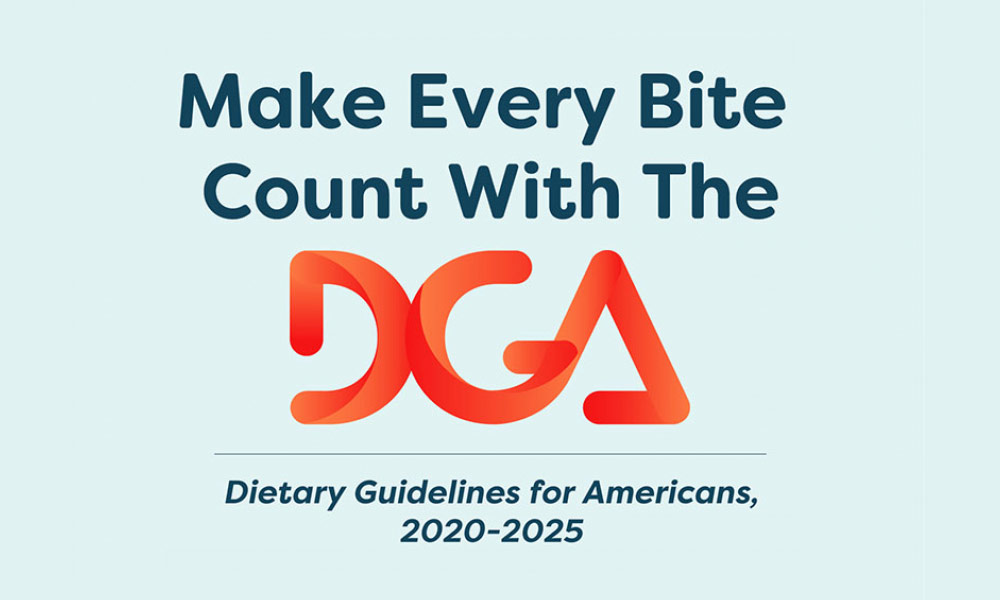Nutrition in America took a major step forward today with the publication of Dietary Guidelines for Americans, 2020-2025. Jointly published every five years by the U.S. Departments of Agriculture (USDA) and Health and Human Services (HHS), these guidelines provide science-based recommendations designed to foster healthy dietary patterns for Americans of all ages.
For the first time, this edition expands the guidance to includes a recommended healthy diet for infants and toddlers.
“At USDA and HHS, we work to serve the American people – to help every American thrive and live healthier lives through access to healthy foods and providing nutrition recommendations,” said U.S. Secretary of Agriculture Sonny Perdue. “With the release of the dietary guidelines, we have taken the very important step to provide nutrition guidance that can help all Americans lead healthier lives by making every bite count.”
This sentiment remains prominent throughout the policy document and complements the four overarching guidelines, which encourage Americans to “Make Every Bite Count” by:
- Following a healthy dietary pattern at every life stage.
- Customizing and enjoying nutrient-dense food and beverage choices to reflect personal preferences, cultural traditions, and budgetary considerations.
- Focusing on meeting food group needs with nutrient-dense foods and beverages from five food groups – vegetables, fruits, grains, dairy and fortified soy alternatives, and proteins – and staying within calorie limits.
- Limiting foods and beverages higher in added sugars, saturated fat, and sodium, and limiting alcoholic beverages.
Dietary Guidelines for Americans is the nation’s trusted resource for evidence-based nutrition guidance. The guidelines are designed for use by healthcare professionals and policy makers for outreach to the general public and provide the nutritional foundation for federal nutrition programs. The dietary guidelines should not be considered clinical guidelines for the treatment of disease.
“The science tells us that good nutrition leads to better health outcomes, and the new dietary guidelines use the best available evidence to give Americans the information they need to make healthy decisions for themselves and their families,” said HHS Secretary Alex Azar. “USDA and HHS have expanded this edition of the dietary guidelines to provide new guidance for infants, toddlers, and pregnant and breastfeeding women, helping all Americans to improve their health, no matter their age or life stage.”
As always, the new guidelines build on the previous editions and were informed by the scientific report developed by the Dietary Guidelines Advisory Committee, along with comments from the public and input from federal agencies. USDA and HHS thank the committee for their work and dedication over the last fifteen months, providing the departments with a comprehensive scientific review and proposal of overarching recommendations, a highly regarded step of critical importance in dietary guidelines development. USDA and HHS also made transparency a priority in this edition and appreciate the many public comments that were received throughout this process.
Today’s release provides the public with the most up-to-date evidence on dietary behaviors that promote health and may help prevent chronic disease. Steeped in scientific evidence, the key recommendations look similar to those of the past and address two topics that garnered much attention throughout the development of the guidelines – added sugars and alcoholic beverages. As in previous editions, limited intake of these two food components is encouraged.
For consumers, USDA’s MyPlate translates and packages these principles of dietary guidance for Americans in a way that is handy and accessible. To share these messages broadly, USDA offers the Start Simple with MyPlate campaign and a new MyPlate website to help individuals, families, and communities make healthy food choices that are easy, accessible, and affordable, in addition to helping prevent chronic disease. For more information, please visit www.myplate.gov.
 Benefits.com Advisors
Benefits.com Advisors
With expertise spanning local, state, and federal benefit programs, our team is dedicated to guiding individuals towards the perfect program tailored to their unique circumstances.
Rise to the top with Peak Benefits!
Join our Peak Benefits Newsletter for the latest news, resources, and offers on all things government benefits.




















